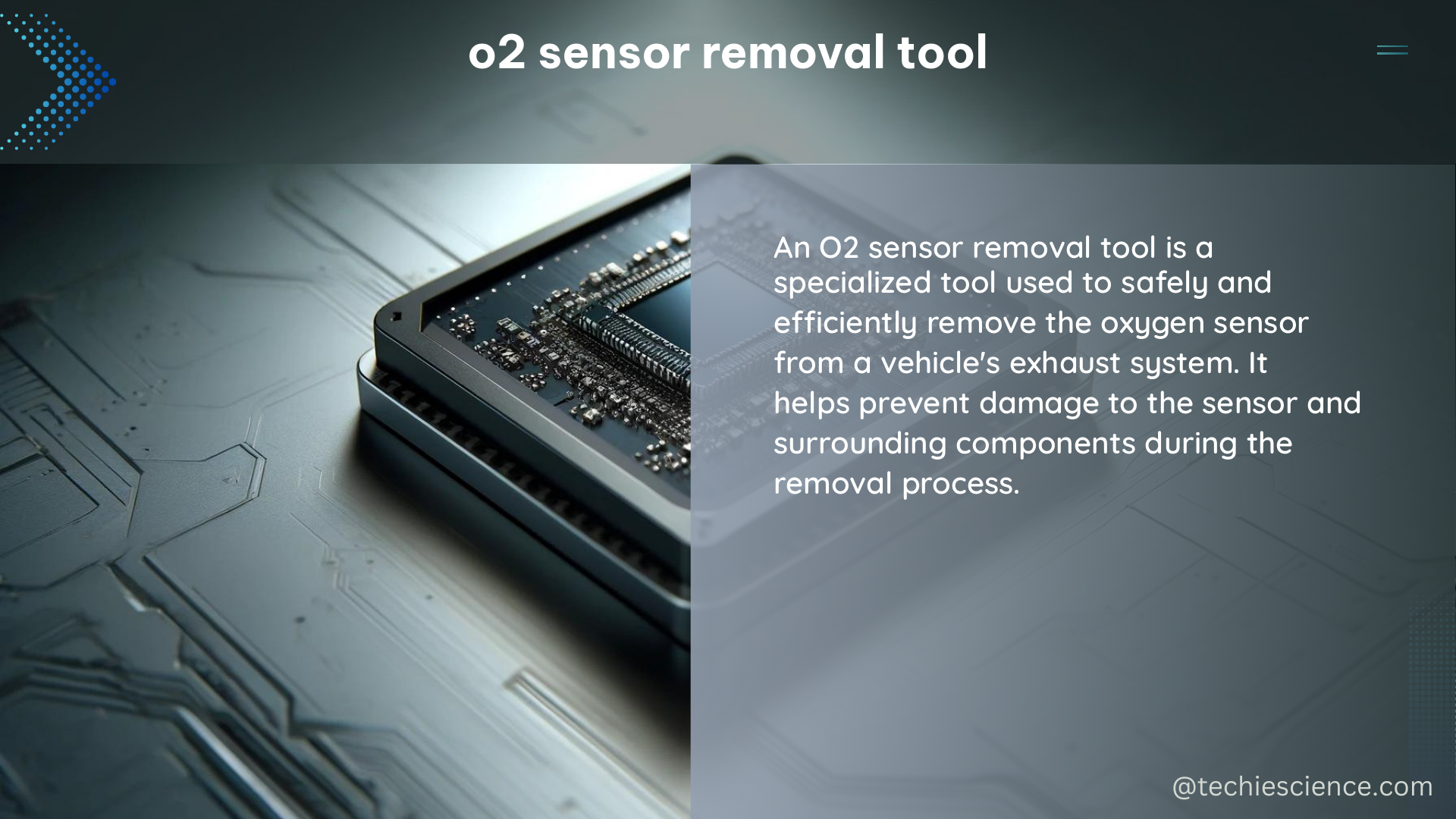The O2 sensor removal tool is a specialized socket designed to remove oxygen sensors from exhaust systems. It is typically a 1/2″ drive 7/8″ deep socket with a slit down the side to allow the sensor wires to stick out. This tool is necessary because the O2 sensors are often tightly secured and can be challenging to remove with standard tools.
Understanding the Anatomy of an O2 Sensor Removal Tool
An O2 sensor removal tool is a specialized socket that is designed to fit the unique shape and size of oxygen sensors found in vehicle exhaust systems. The key features of an O2 sensor removal tool include:
- Drive Size: The most common drive size for an O2 sensor removal tool is 1/2″, which provides the necessary torque to loosen even the most stubborn sensors.
- Socket Depth: The socket depth is typically 7/8″, which is the standard depth required to fully engage the sensor.
- Slit Design: The slit down the side of the socket allows the sensor wires to pass through, enabling the tool to be positioned around the sensor without damaging the wiring.
- Material Composition: High-quality O2 sensor removal tools are often made from chrome-vanadium steel, which provides superior strength and durability to withstand the high torque required for sensor removal.
- Hexagonal Shape: The socket is designed with a hexagonal shape to match the hexagonal shoulders of the O2 sensor, ensuring a secure and non-slip grip.
Preparing for O2 Sensor Removal

Before attempting to remove an O2 sensor, it’s essential to properly prepare the work area and gather the necessary tools. Here’s a checklist to ensure a successful sensor removal:
- Exhaust System Warm-up: Heating the exhaust system, particularly the bung (the part of the exhaust system where the sensor screws in), can significantly ease the removal process. Use a propane torch or map gas to heat the bung until it just starts to turn red.
- Proper Tool Selection: Ensure that you have the correct O2 sensor removal tool for your specific vehicle. The tool should be a 1/2″ drive 7/8″ deep socket with a slit down the side.
- Additional Tools: In addition to the O2 sensor removal tool, you may also need a cheater bar, an impact wrench, or a 6-point box wrench to provide the necessary torque for sensor removal.
- Safety Gear: Wear appropriate personal protective equipment (PPE), such as safety glasses, gloves, and heat-resistant clothing, to protect yourself during the removal process.
Techniques for Removing the O2 Sensor
Once you have the exhaust system warmed up and the necessary tools ready, you can proceed with the O2 sensor removal. Here are the step-by-step instructions:
- Locate the O2 Sensor: Identify the location of the O2 sensor in the exhaust system. This is typically near the catalytic converter or the engine.
- Position the Removal Tool: Carefully position the O2 sensor removal tool around the sensor, ensuring that the slit in the socket aligns with the sensor wires.
- Apply Torque: Using a cheater bar or an impact wrench, apply steady and controlled torque to the removal tool to loosen the sensor. Be patient and avoid excessive force, as this can damage the sensor or the exhaust system.
- Monitor for Resistance: If the sensor is particularly stubborn, you may need to reapply heat to the bung and try again. Avoid using excessive force, as this can lead to damage.
- Cutting the Wires: If the sensor is being replaced, you can also try cutting the sensor wires and using a 7/8″ or 22mm box wrench to remove the sensor. This method can be effective, but it’s essential to use a 6-point tool to avoid rounding off the shoulders of the sensor.
Troubleshooting Stubborn O2 Sensors
In some cases, the standard O2 sensor removal tool may not be sufficient for removing a particularly stubborn sensor. In these situations, you can try the “heat wrench” method:
- Oxy-Acetylene Torch: Use an oxy-acetylene torch to heat the bung until it’s glowing red. This will help to expand the metal and loosen the sensor.
- Split Socket or Tube Wrench: Immediately after heating the bung, use a split socket or a heavy-duty tube wrench to attempt to remove the sensor. The combination of heat and the specialized tool should provide the necessary torque to loosen the sensor.
Remember, always exercise caution when using an oxy-acetylene torch, as it can pose a significant fire hazard. Ensure that the work area is well-ventilated and that you have a fire extinguisher nearby.
Conclusion
The O2 sensor removal tool is a crucial tool for any DIY enthusiast or professional mechanic who needs to service or replace oxygen sensors in a vehicle’s exhaust system. By understanding the anatomy of the tool, properly preparing the work area, and employing the right techniques, you can successfully remove even the most stubborn O2 sensors with confidence. Remember to always prioritize safety and use the appropriate personal protective equipment to ensure a safe and successful sensor removal process.
References:
– How to Remove an Oxygen Sensor
– Oxygen Sensor Removal: What Tool?
– Socket for Sensor Removal
– O2 Sensor is Too Tight – Ideas to Remove It
– Oxygen Sensor Wrenches Help

The lambdageeks.com Core SME Team is a group of experienced subject matter experts from diverse scientific and technical fields including Physics, Chemistry, Technology,Electronics & Electrical Engineering, Automotive, Mechanical Engineering. Our team collaborates to create high-quality, well-researched articles on a wide range of science and technology topics for the lambdageeks.com website.
All Our Senior SME are having more than 7 Years of experience in the respective fields . They are either Working Industry Professionals or assocaited With different Universities. Refer Our Authors Page to get to know About our Core SMEs.